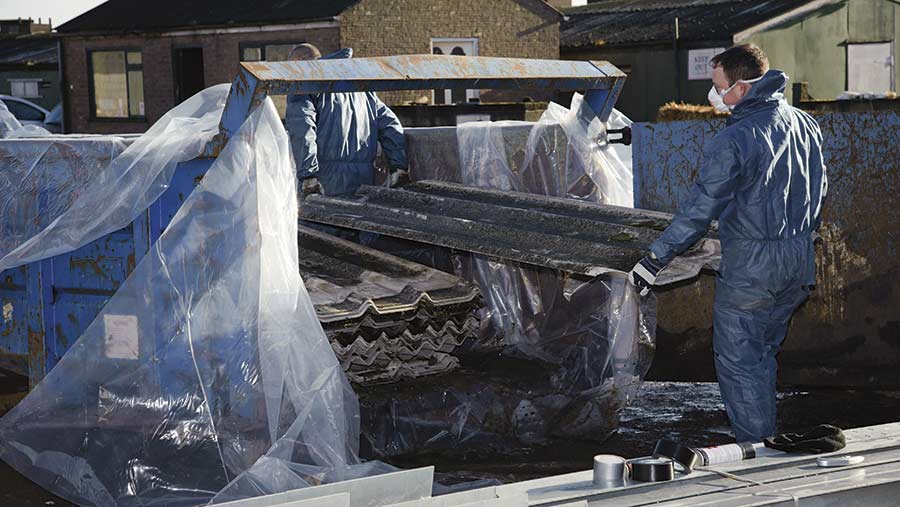A common question among mesothelioma patients, or even people just interested in learning about the cancer, revolves around levels of asbestos exposure.
They ask, “How much asbestos must you be exposed to in order to develop mesothelioma?” or “How often must asbestos exposure occur for you to be in danger?”
The answer is simple: any amount or frequency greater than zero.
Even if you were exposed to a low quantity or just one instance of exposure, you could still be at risk. A BMJ Case Reports abstract published last week reasserts this fact. The study analyzed the case of a pleural mesothelioma patient who had “remote, short-term asbestos exposure.”
How Mesothelioma Develops in Your Body
Exposure to asbestos particles is the only cause of mesothelioma, a rare disease with around 3,300 new cases in the United States each year. Mesothelioma originates most often in the lining between the lung cavity and chest wall. This space is called the pleura, and the disease is known explicitly as pleural mesothelioma.
Mesothelioma can also form in the peritoneum, which is a thin membrane wrapping around the abdominal cavity. This form of cancer is called peritoneal mesothelioma.

Asbestos can enter the body either through breathing in or swallowing loose fibers. These sharp pieces of dust can then penetrate the cells that comprise these small linings. If the fibers aren’t expelled from the body — and instead irritate the cells — then cellular mutations can occur.
The more often someone is exposed to asbestos — and the more of the mineral they interact with — the more likely these loose fibers enter their body and irritate cells. However, just one instance — or even one piece of fragmented asbestos dust — could turn healthy cells into diseased ones. Because this disease has a latency period of 20-50 years, seniors are at the greatest risk of being diagnosed.
Where Asbestos Exposure Occurs
The report concludes with the same sentiment regarding mesothelioma and asbestos exposure levels. The study showed why “the degree of asbestos exposure to induce malignant mesothelioma may be smaller than has been traditionally thought.”
The most common source of asbestos exposure is occupational. Construction, insulation, electrical and automobile mechanic work all involved asbestos parts for decades — up until the very end of the 20th century. Many other trades — such as baking, boiler work, and plumbing — also likely involved regular exposure.
However, as the study shows, any instance of exposure could cause mesothelioma. Since asbestos was so widely used — in addition to mining and production facilities — throughout the 20th century, the mineral is just about everywhere. People can be exposed to loose asbestos particles without ever working in an at-risk occupation.
Asbestos Exposure During Your Working Years
Prior to 1980, the United States government did not set any major limitations on the use of asbestos. Because of the lack of regulations, workers from 1940s to 1970s were exposed to the deadly carcinogen at extremely unsafe levels. A variety of occupations involve high levels of exposure in order for workers to complete their job duties and many continue to include the risk of asbestos exposure. These occupations include:
- S. Armed Forces
- Construction trade workers
- Shipbuilders
- Automotive workers
- Electricians
- Among similar jobs
Many baby boomers were established in their careers when regulations on the use of asbestos began. Although instances of occupational asbestos exposure declined as working conditions and regulations regarding asbestos were established, the use of asbestos in industrial fields has not ended. For retired baby boomers, exposure occurred many years ago, but exposed workers are not out of the woods yet.
 Secondhand exposure is also a threat to consider, as workers bring home asbestos-covered clothing which could have exposed their children or spouses through close contact. Many workers, such as military personnel, who worked on ships or with construction personnel also faced secondary exposure. Around 30% of all mesothelioma cases in the U.S. involve military veterans.
Secondhand exposure is also a threat to consider, as workers bring home asbestos-covered clothing which could have exposed their children or spouses through close contact. Many workers, such as military personnel, who worked on ships or with construction personnel also faced secondary exposure. Around 30% of all mesothelioma cases in the U.S. involve military veterans.
Paying For Treatment
Mesothelioma treatment is expensive — costing patients thousands (or even hundreds of thousands) of dollars. Most patients and their families do not make enough money or have enough savings to pay for it. They accept the fact that they will have some medical debt. If the patient passes away, then the family is left to pay off the bills for surgery, chemotherapy, radiation, and more.
A mesothelioma lawsuit can solve this issue. The companies that exposed you and others to asbestos are responsible for your diagnosis. They are accountable for your medical bills, and they should pay for them.
Filing a mesothelioma lawsuit takes this burden off you and your family.
Once diagnosed, you should focus on treatment first and foremost. Your other priority is spending as much time as possible doing what you love — with the people whom you love.
The Bottom Line
Finding a mesothelioma lawyer and then filing a lawsuit can take time away from these objectives. Time spent compiling evidence and investigating how you were exposed to asbestos is time not spent trying to beat this disease. This is fair, but it is also not how the top mesothelioma law firms operate.
The best attorneys do all the legal work for your case. They will investigate your employment history, travel to you for all meetings, choose the best route to take your claim, and file all motions. If possible, they will even shield you from having to go to court for any proceedings.
With the best law firms, you will not have to worry about legal matters. Your mesothelioma lawsuit will move along without you needing to lift a finger.
Who are the authors?
Kimberly Cruz-Montalvo is the Community Outreach Representative for Mesothelioma Guide and Devin Golden is the content writer for Mesothelioma Guide. He produces mesothelioma-related content on various mediums, including the Mesothelioma Guide website and social media channels. Devin’s objective is to translate complex information regarding mesothelioma into informative, easily absorbable content to help patients and their loved ones.



![women [longevity live]](https://longevitylive.com/wp-content/uploads/2020/01/photo-of-women-walking-down-the-street-1116984-100x100.jpg)










